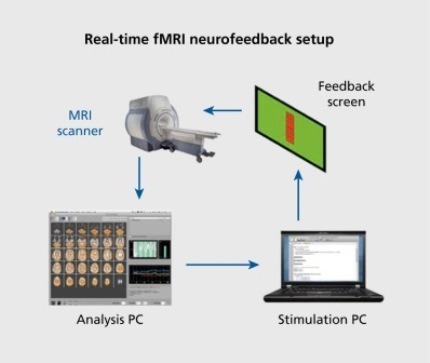Study: Harnessing fMRI neurofeedback to enhance attention and cognitive potential

.
Real-time brain feedback reduces attention lapses (News at Princeton):
“In an article published online Monday by the journal Nature Neuroscience, researchers at Princeton University describe a study that shows training people using real-time feedback from their own brain activity can reduce the frequency of attention lapses and improve their ability to sustain attention.
“Even though we all make a lot of attentional errors and we have difficulty focusing, there’s some potential for those abilities to improve,” said Nicholas Turk-Browne…the research offers basic science insights into how attention works in the brain and how attention-related mental processes can change. It also opens the door, he said, to potential practical applications for training in occupational settings, such as truck driving and baggage screening, where sustained attention is required. In addition, the research could prove helpful in treatment of disorders such as attention deficit hyperactivity disorder and aspects of depression that are related to attention.
In the study, the researchers used real-time functional magnetic resonance imaging (rtfMRI) to monitor the brain activity of participants as they completed a task that involved looking at an image that blended a face and a scene.
To complete the task, the study participants needed to focus their attention on either the face or the scene part of the image. When the rtfMRI information indicated that their attention was wandering away from that part of the image, the researchers made the task more difficult by fading out that part of the blended image.”
Study: Closed-loop training of attention with real-time brain imaging (Nature Neuroscience)
- Abstract: Lapses of attention can have negative consequences, including accidents and lost productivity. Here we used closed-loop neurofeedback to improve sustained attention abilities and reduce the frequency of lapses. During a sustained attention task, the focus of attention was monitored in real time with multivariate pattern analysis of whole-brain neuroimaging data. When indicators of an attentional lapse were detected in the brain, we gave human participants feedback by making the task more difficult. Behavioral performance improved after one training session, relative to control participants who received feedback from other participants’ brains. This improvement was largest when feedback carried information from a frontoparietal attention network. A neural consequence of training was that the basal ganglia and ventral temporal cortex came to represent attentional states more distinctively. These findings suggest that attentional failures do not reflect an upper limit on cognitive potential and that attention can be trained with appropriate feedback about neural signals.
Learn more:


